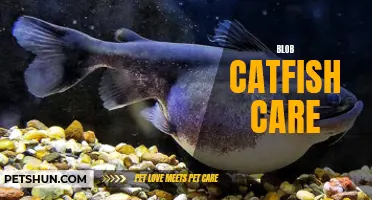
If you're a fish enthusiast with a large aquarium, chances are you've considered adding a synodontis catfish to your collection. These unique and fascinating creatures come in a variety of breeds, each with its own distinct characteristics and quirks. Whether you're looking for a stunning centerpiece or a friendly tank mate, there's a synodontis catfish breed out there for you. So, grab your fishnet and get ready to dive into the world of synodontis catfish!
What You'll Learn
- What are some different breeds of synodontis catfish that are suitable for a large aquarium?
- Which synodontis catfish breeds are known for their size and ability to thrive in larger tanks?
- Are there any specific breeds of synodontis catfish that are more aggressive or territorial and may not be suitable for a community aquarium?
- What are the recommended water parameters for different breeds of synodontis catfish in a large aquarium?
- Are there any specific feeding requirements or dietary preferences for different breeds of synodontis catfish in a large aquarium?

What are some different breeds of synodontis catfish that are suitable for a large aquarium?
Synodontis catfish are a popular choice for large aquariums due to their unique appearance and interesting behaviors. There are several different species and breeds of synodontis catfish that are suitable for large aquariums, each with its own characteristics and requirements.
One popular breed of synodontis catfish is the Synodontis multipunctatus, also known as the cuckoo catfish. This breed is known for its ability to spawn inside the mouth of mouthbrooding cichlids, making it a fascinating addition to any large aquarium with cichlids. However, it is important to note that this breed can be territorial and aggressive towards other fish, so it is best kept with larger, more aggressive tank mates.
Another breed of synodontis catfish suitable for large aquariums is the Synodontis eupterus, also known as the featherfin catfish. This breed is characterized by its long, flowing fins and vibrant coloration. Featherfin catfish are generally peaceful and can be kept with a variety of tank mates, but they do require plenty of hiding places and a sandy substrate to mimic their natural habitat.
The Synodontis petricola, or pygmy synodontis, is a smaller breed of synodontis catfish that is well-suited for large aquariums. While they are small in size, they make up for it with their unique appearance and interesting behaviors. Pygmy synodontis are known for their ability to climb and cling to vertical surfaces, so it is important to provide plenty of rocks and wood in the aquarium for them to explore. They also prefer a sandy substrate to sift through, as they are bottom feeders.
One of the larger breeds of synodontis catfish suitable for large aquariums is the Synodontis granulosus, also known as the granulated catfish. This breed can grow up to 15 inches in length and requires a spacious tank with plenty of swimming space. Granulated catfish are generally peaceful and can be kept with a variety of tank mates, but they may become territorial during feeding time. Therefore, it is important to provide multiple feeding areas to prevent any aggression.
In conclusion, there are several different breeds of synodontis catfish that are suitable for large aquariums. Each breed has its own unique characteristics and requirements, so it is important to research and choose the breed that best fits your aquarium setup and tank mates. Whether you prefer the spawning behaviors of the cuckoo catfish, the vibrant coloration of the featherfin catfish, the unique behaviors of the pygmy synodontis, or the impressive size of the granulated catfish, there is a synodontis catfish breed that is sure to make a stunning addition to your large aquarium.
The Ultimate Guide to Anchor Catfish Care for Beginners
You may want to see also

Which synodontis catfish breeds are known for their size and ability to thrive in larger tanks?
Synodontis catfish are a popular choice for many aquarium enthusiasts due to their unique appearance and behavior. While there are several different species of Synodontis catfish, some stands out for their large size and ability to thrive in larger tanks.
One well-known species is the Synodontis eupterus, also known as the Featherfin Synodontis. This species can grow up to 10 inches in length and requires a tank of at least 55 gallons. Featherfin Synodontis are known for their striking appearance, with a long, flowing dorsal fin and a beautiful pattern on their body. They are also relatively peaceful, making them a good choice for community tanks with larger fish.
Another species that can thrive in larger tanks is the Synodontis angelicus, also known as the Upside-down Catfish. As the name suggests, this catfish species is often seen swimming upside down near the surface of the water. They have a unique ability to breathe air, allowing them to survive in low-oxygen environments. Synodontis angelicus can reach lengths of up to 6 inches and should be kept in a tank of at least 30 gallons. They are peaceful and can coexist with other non-aggressive fish species.
The Synodontis decorus, also known as the Clown Synodontis, is another species that can reach a larger size and requires a larger tank. They can grow up to 10 inches and should be housed in a tank of at least 55 gallons. The Clown Synodontis is named for its striking coloration and pattern, which resembles that of a clownfish. They are known to be peaceful and can be kept with a variety of tankmates, as long as they are not aggressive.
When setting up a tank for larger Synodontis catfish species, it is important to provide plenty of hiding spots and caves for them to explore. These catfish are nocturnal and will spend much of their time hiding during the day. Rocks, driftwood, and PVC pipes can be used to create hiding spots in the tank. It is also important to provide a sandy substrate, as these catfish like to sift through the substrate in search of food.
Feeding larger Synodontis catfish can be a bit tricky, as they are primarily omnivorous but also enjoy meaty foods. A diet of high-quality catfish pellets, supplemented with live or frozen foods such as bloodworms or brine shrimp, is recommended. It is also important to provide a varied diet to ensure that they receive all the necessary nutrients.
In conclusion, several Synodontis catfish species are known for their large size and ability to thrive in larger tanks. The Featherfin Synodontis, Upside-down Catfish, and Clown Synodontis are all great choices for aquariums with ample space. By providing the proper tank setup and a balanced diet, these catfish can flourish and become the centerpiece of any larger aquarium.
Aquarium Furniture Essentials for Housing Channel Catfish
You may want to see also

Are there any specific breeds of synodontis catfish that are more aggressive or territorial and may not be suitable for a community aquarium?
Synodontis catfish are a popular choice for aquarium enthusiasts due to their unique appearances and interesting behaviors. These catfish are known for their ability to live in various water conditions and their peaceful nature, making them suitable for community aquariums. However, there are some specific breeds of synodontis catfish that may exhibit more aggressive or territorial behavior, and therefore may not be suitable for a community setup.
One such breed is the Synodontis multipunctatus, also known as the cuckoo catfish. This species is known for its aggressive behavior, especially during breeding periods. In the wild, the cuckoo catfish lays their eggs in the nests of mouthbrooding cichlids, tricking the cichlid into raising their young. This behavior can lead to conflicts in an aquarium setup, as the cuckoo catfish may become aggressive towards other fish.
Another breed to watch out for is the Synodontis granulosus, commonly known as the granulated catfish. These catfish are more territorial in nature and may defend their preferred hiding spots or territories in the aquarium. They are also known to become aggressive when spawning, which can lead to conflicts with other fish.
To successfully keep synodontis catfish in a community aquarium, it is important to carefully choose compatible tank mates. Avoid pairing them with fish that are known to be aggressive or territorial, as this can lead to fights and stress for the catfish. Instead, choose peaceful fish species that are less likely to pose a threat to the synodontis catfish.
In addition, providing plenty of hiding spots and territories in the aquarium can help reduce aggression and territorial behavior. Synodontis catfish are known to be reclusive and will appreciate the presence of caves, rocks, or driftwood to retreat to. This will allow them to establish their own territories and reduce the likelihood of conflicts with other fish.
It is also important to ensure that adequate space is provided for the synodontis catfish. Overcrowding can lead to increased stress and aggression, so make sure the tank size and stocking levels are suitable for the number of fish in the aquarium.
Lastly, it is worth noting that individual personalities can vary within a species, and not all synodontis catfish of a specific breed will display aggressive or territorial behavior. Nonetheless, it is best to be cautious and research the specific breed of synodontis catfish you are interested in before adding them to a community aquarium.
In conclusion, while synodontis catfish are generally peaceful and suitable for community aquariums, some specific breeds may exhibit more aggressive or territorial behavior. It is important to research and choose compatible tank mates, provide adequate hiding spots and territories, and ensure proper tank size and stocking levels to maintain a harmonious community aquarium.
The Ultimate Guide to Using a Lead Method Feeder for Catfish
You may want to see also

What are the recommended water parameters for different breeds of synodontis catfish in a large aquarium?
Synodontis catfish are a popular choice among aquarists for their unique appearance and interesting behaviors. These catfish come in various species, with each having its own specific water parameter requirements. In this article, we will discuss the recommended water parameters for different breeds of synodontis catfish in a large aquarium.
Temperature:
Most species of synodontis catfish thrive in temperatures between 72°F (22°C) to 82°F (28°C). It is important to maintain a stable temperature within this range to prevent stress and ensure optimal health. Using a reliable aquarium heater and thermometer can help maintain the desired temperature.
PH Level:
The ideal pH level for synodontis catfish varies depending on the species. However, most species prefer slightly acidic to neutral water conditions. A pH range of 6.5 to 7.5 is generally suitable for most synodontis catfish. Regular monitoring of pH levels and using appropriate pH stabilizers can help maintain the desired conditions.
Hardness:
Synodontis catfish are known to adapt to a wide range of water hardness. However, as a general guideline, a moderate level of hardness is preferred. Aim for a water hardness of around 5 to 15 dGH (degrees of German hardness) for optimal health and breeding conditions.
Ammonia and Nitrite Levels:
Synodontis catfish are sensitive to ammonia and nitrite levels in the aquarium. Both ammonia and nitrite are toxic to fish and can cause severe health issues. It is crucial to maintain a well-established aquarium nitrogen cycle and monitor ammonia and nitrite levels regularly. Aim for ammonia and nitrite levels of zero to ensure the best conditions for your catfish.
Filtration:
Adequate filtration is essential for a large aquarium housing synodontis catfish. These catfish produce a fair amount of waste, and a strong filtration system will help maintain water quality and prevent ammonia and nitrite buildup. Use a filter with a sufficient flow rate and consider adding biological media to enhance the filtration process.
Oxygenation:
Synodontis catfish require well-oxygenated water to thrive. In a large aquarium, it is important to ensure proper water circulation and oxygenation. Use an air pump or install additional water circulation devices to maintain healthy oxygen levels throughout the aquarium.
It is important to note that these are general guidelines for synodontis catfish and that specific species may have additional or slightly different requirements. It is always recommended to research the specific needs of the synodontis catfish species you plan to keep and adjust the water parameters accordingly.
In conclusion, providing the recommended water parameters for synodontis catfish in a large aquarium is crucial for their overall health and well-being. Maintaining stable temperature, pH levels, water hardness, and ammonia and nitrite levels are essential. Additionally, ensuring proper filtration and oxygenation will help create a suitable environment for these unique and fascinating catfish.
Feeding Frenzy: Catfish Devours Tankmate in Aquarium Battle
You may want to see also

Are there any specific feeding requirements or dietary preferences for different breeds of synodontis catfish in a large aquarium?
Synodontis catfish are a diverse group of fish known for their interesting appearance and behavior. With over 150 different species, each with its own unique characteristics, it can be challenging to determine the specific feeding requirements and dietary preferences for each breed.
In a large aquarium, it is important to provide a balanced and varied diet to ensure the optimal health and well-being of your synodontis catfish. These catfish are omnivorous, meaning they will consume both plant and animal matter in their natural habitat. Therefore, it is crucial to offer a mix of both types of food in their diet.
When it comes to plant matter, consider offering your synodontis catfish a variety of vegetables and algae-based foods. This can include blanched zucchini or lettuce, spirulina-based food pellets, and algae wafers. These foods will provide essential vitamins and minerals that are vital for their overall health.
In terms of animal matter, synodontis catfish are known to consume small invertebrates such as worms, brine shrimp, and bloodworms. These can be offered as live or frozen foods, ensuring that your catfish is receiving a good source of protein. Additionally, sinking pellets or granules that contain a high percentage of animal-based protein can be provided as a staple food source.
It is crucial to note that the feeding requirements and preferences of synodontis catfish can vary depending on the specific species. Some catfish may have a higher preference for plant matter, while others may require a predominantly animal-based diet. Therefore, it is recommended to research the specific breed of synodontis catfish you have to determine their unique dietary needs.
When feeding your synodontis catfish, it is essential to provide small and frequent meals throughout the day. These catfish are known to be active feeders and can eat a significant amount of food in a short period. By spreading out their meals, you can ensure that they are getting an adequate amount of food without overfeeding them.
In addition to offering a balanced diet, it is essential to provide hiding places and structures within the aquarium. Synodontis catfish are nocturnal and appreciate places to rest and hide during the day. This can be achieved by adding caves or driftwood to the tank, allowing them to exhibit their natural behavior and reduce stress.
In conclusion, synodontis catfish in a large aquarium have specific feeding requirements and dietary preferences. It is important to offer a mix of both plant and animal matter to ensure a balanced diet. Researching the specific breed of synodontis catfish you have will help determine their unique dietary needs. Remember to provide hiding places and structures within the tank to mimic their natural habitat. By following these guidelines, you can ensure the optimal health and well-being of your synodontis catfish in a large aquarium.
The Ultimate Guide to Caring for Crystal Eyed Catfish
You may want to see also
Frequently asked questions
Some popular breeds of Synodontis catfish for large aquariums include Synodontis granulosus, Synodontis angelicus, and Synodontis multipunctatus.
Synodontis granulosus catfish can grow up to 10 inches in length, making them a great addition to large aquariums.
Synodontis catfish are generally peaceful and can coexist well with other fish in a large aquarium. However, they may become territorial during breeding season, so it's important to provide them with enough space and hiding spots.







